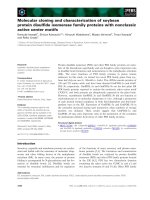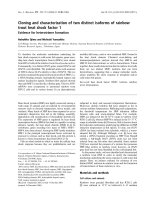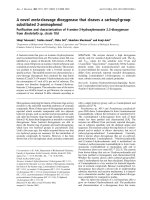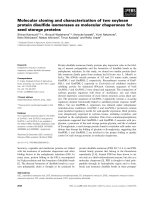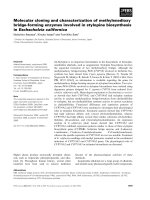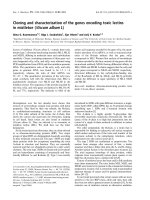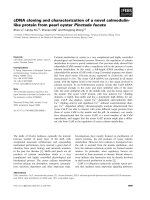molecular cloning and characterization of ghwrky11 a gene implicated in pathogen responses from cotton
Bạn đang xem bản rút gọn của tài liệu. Xem và tải ngay bản đầy đủ của tài liệu tại đây (1.37 MB, 11 trang )
Available online at www.sciencedirect.com
South African Journal of Botany 81 (2012) 113 – 123
www.elsevier.com/locate/sajb
Molecular cloning and characterization of GhWRKY11, a gene implicated in
pathogen responses from cotton
J. Sun, H. An, W. Shi, X. Guo, H. Li ⁎
State Key Laboratory of Crop Biology, Shandong Key Laboratory of Crop Biology, College of Life Sciences, Shandong Agricultural University, Taian,
Shandong 271018, People's Republic of China
Received 7 May 2012; received in revised form 17 June 2012; accepted 19 June 2012
Available online 20 July 2012
Abstract
WRKY transcription factors are key regulators in signaling networks that modulate many plant defense processes. Although the functions of
WRKY proteins have been well studied in model plants, their roles in cotton pathogen defense mechanism are still unknown. In the present study,
we cloned a cotton group IId WRKY transcription factor gene, designated as GhWRKY11, which has only one copy in cotton genome and was
targeted to the nucleus. Promoter sequence analysis revealed various cis-acting elements related to plant defense responses. Furthermore, semiquantitative RT-PCR analysis indicated that GhWRKY11 was induced by pathogen (Colletotrichum gossypii) attack, wounding treatment and
certain defense-related molecules, including salicylic acid (SA), methyl jasmonate (MeJA), ethylene (ET) and hydrogen peroxide (H2O2). In
addition, overexpression of GhWRKY11 in Nicotiana benthamiana resulted in an elevated resistance potential to cucumber mosaic virus (CMV)
compared to the wild-type, following the enhanced transcript levels of SA associated genes (PR1 and NPR1) and reduced H2O2 accumulation.
These results suggest that GhWRKY11 may play important roles in regulating plant defense responses through SA- and reactive oxygen species
(ROS)-mediated signal pathways.
© 2012 SAAB. Published by Elsevier B.V. All rights reserved.
Keywords: Cotton; GhWRKY11; Defense response; SA; ROS
1. Introduction
Living plant tissues are host to various pathogens. To cope
with these threats, plants develop a wide array of plant defense
mechanisms in a highly extensive and temporal manner. These
sophisticated mechanisms are regulated by phytohormones such
as salicylic acid (SA), jasmonic acid (JA) and ethylene (ET). SA
plays a positive role against biotrophic pathogens, while JA
appears to be vital in the case of necrotrophic pathogens (Mur et
al., 2006; Thomma et al., 2001). Both the SA and JA/ET
mediated signaling pathways require the expression of a large
number of genes including pathogenesis-related (PR) genes
(Bohnert et al., 1995). The regulation of PR genes is mainly
⁎ Corresponding author. Tel.: +86 538 8249697; fax: + 86 538 8242217.
E-mail address: (H. Li).
achieved by enforcement of a network of various transcription
factors (Chen and Zhu, 2004). By now, many plant transcription
factors have been shown to contribute to this regulation, such as
ethylene-responsive-element-binding protein (EREBP), basic
Leucine Zipper (bZIP), MYB proteins, homeodomain and
WRKY transcription factors (Rushton and Somssich, 1998).
WRKY proteins are key zinc finger transcription factors
(Eulgem et al., 2000). Since the first WRKY gene (SPF1) was
identified from sweet potato in 1994, an increasing number of
WRKY proteins have been found throughout the green lineage
(green algae and land plants) (Ishiguro and Nakamura, 1994). To
date, there are 74 identified WRKY proteins in Arabidopsis and
nearly 200 members in soybean (Rushton et al., 2010; Ulker and
Somssich, 2004). WRKY proteins share common features of
transcription factors, such as nuclear localization signal (NLS)
and transactivation capability (Ulker and Somssich, 2004), while
0254-6299/$ -see front matter © 2012 SAAB. Published by Elsevier B.V. All rights reserved.
doi:10.1016/j.sajb.2012.06.005
114
J. Sun et al. / South African Journal of Botany 81 (2012) 113–123
its defining feature is the DNA-binding domain called WRKY
domain, which is identified by the almost invariant WRKYGQK
amino acid sequence at its N-terminus and an atypical zinc-finger
motif at its C-terminus. The zinc-finger motif structure is either
Cx4-5Cx22-23HxH or Cx7Cx23HxC (Rushton et al., 1996).
According to the number of conserved WRKYGQK sequence
and the structure of zinc-finger motif, WRKY proteins can be
categorized into three distinct groups (I, II and III) and each could
be further classified into subgroups based on the additional short
conserved structural motif (Rushton et al., 2010). In addition, this
WRKY domain generally binds to the W-box (C/TTGACT/C)
present in the promoters of a large number of plant
defense-related genes (Maleck et al., 2000; Rushton et al., 1995).
A large body of evidence suggests that WRKY transcription
factors play a vital role in modulating genes associated with
plant defense responses (Pandey and Somssich, 2009; Eulgem
and Somssich, 2007). As reported, the majority of WRKY
proteins from various species could be induced by pathogen
attack. In Arabidopsis, 49 out of 72 tested WRKY genes
respond to an avirulent strain of a bacterial pathogen
Pseudomonas syringae (Dong et al., 2003). In rice, among
the 45 tested WRKY genes, the transcript abundance of 15
genes changed significantly following Magnaporthe grisea
challenge (Ryu et al., 2006). In canola, transcript abundance of
13 BnWRKY genes changed significantly following pathogen
challenge (Yang et al., 2009). Considering the amount of
WRKY transcription factors involved in plant defense
response, more and more reports are focusing on multiple
roles of WRKY proteins in regulating plant defense response,
including both the negative and positive transcript functions.
AtWRKY33 conferred increased susceptibility to two necrotrophic fungi, and silencing of CaWRKY1 in chili pepper
leaves enhanced the resistance to Xanthomonas axonopodis
pv. vesicatoria (Oh et al., 2008; Zheng et al., 2006).
Meanwhile, Arabidopsis overexpressing AtWRKY41 showed
enhanced resistance to the P. syringae pv. tomato DC3000
(Pto) and OsWRKY13 expression was regulated by multiple
factors to achieve disease resistances (Cai et al., 2008; Higashi
et al., 2008). Interestingly, it appears that a given WRKY
protein affects different signaling pathways. AtWRKY62 acts
as a positive regulator in SA-dependent defense response and
negative regulator in JA signaling pathway (Mao et al., 2007).
In addition, WRKY transcription factors have been reported to
be involved in the regulation of reactive oxygen species
(ROS) accumulation. The levels of MusaWRKY71 and
GhWRKY3 transcript were significant increased in the case
of hydrogen peroxide (H2O2) treatment (Guo et al., 2011;
Shekhawat et al., 2011).
Among the various WRKY proteins, group IId transcription
factors are a group of important protein family in plant defense.
The common feature of this subgroup is the C-region, which
bounds calcium ions known to act as a second messenger (Park et
al., 2005). Dong et al. had reported that this group of proteins
could be induced by pathogen attack and SA treatment, which
generate calcium ions (Dong et al., 2003). In Arabidopsis, there
are 7 group IId transcription factors. Among these genes,
AtWRKY11 and AtWRKY17 act as negative regulators in
JA-dependent resistance (Journot-Catalino et al., 2006).
AtWRKY7 plays a negative role in defense responses to
P. syringae (Kim et al., 2006). However, the knowledge about
other group IId genes is rather limited, especially in cotton.
Cotton is an important economic crop and used widely in the
textile industry. However, it is suffering threats from various
pathogens. To cope with those threats, genetic engineering was
performed to improve cotton resistance, in which WRKY
transcriptional factors play a critical role. Until now, a limited
number of reports about the identification of WRKY transcription factors from cotton significantly conceal their biological
application in cotton planting. In this study, we isolated a cotton
WRKY transcriptional factor, termed as GhWRKY11, that
conformed well to the general features of group IId WRKY
superfamily. Expression analysis indicated that GhWRKY11
expression is up-regulated through partial defense signals.
Furthermore, GhWRKY11-overexpressing plants displayed an
enhanced resistance to virus challenge through SA-dependent
signaling pathway, followed by reduced H2O2 accumulations.
Thus, we speculated that GhWRKY11 may play a significant
role in regulating plant pathogen defense responses.
2. Materials and methods
2.1. Plant materials and growth conditions
Cotton (Gossypium hirsutum L. cv. Lumian 22) was kept at
28 °C in a growth room programmed with 16 h light/8 h dark
cycle. The following treatments were performed on sevenday-old cotton seedlings. For the treatment with various
signaling molecules, seedling leaves were sprayed with methyl
jasmonate (MeJA, 100 μM), SA (2 mM), H2O2 (10 mM) and
ethylene released from 5 mM ethephon, respectively. Meanwhile, seedling leaves were cut with scissors for wounding
treatment. For pathogen-infection treatment, the fungal pathogen
Colletotrichum gossypii (C. gossypii) were cultivated at 28 °C
on potato dextrose agar (PDA) medium for 15 d, and then fungal
colonies were transferred into 1% glucose solution for conidia
harvest. The conidial suspension (10 5 conidia mL − 1) was used
to inoculate cotton seedlings with dip method. Then the
challenged cottons were placed in a moist chamber under
growth room conditions. All the samples were immediately
frozen in liquid nitrogen at the appropriate time and stored at −
80 °C for later use.
Nicotiana benthamiana (N. benthamiana) were cultivated at
greenhouse condition at 26 ± 1 °C with a 16 h light/8 h dark
cycle. For virus treatment, transgenic and wild-type plants were
inoculated with 100 μL cucumber mosaic virus (CMV)
suspensions (CMV in 50 mM phosphate buffer, pH 7.2)
through wiping the fully expanded true leaves with CMV,
and harvested at the appropriate time.
2.2. RNA isolation, cDNA synthesis and DNA preparation
Total RNA was extracted from cotton seedlings prepared
above using Trizol reagent (Invitrogen, USA) according to the
manufacturer's protocol. All the RNA samples were treated
J. Sun et al. / South African Journal of Botany 81 (2012) 113–123
with RNase-free DNaseI (Promega, USA) to remove the
potential genomic DNA contamination and then stored at −
80 °C for future cDNA synthesis. Each RNA extraction was
performed with pooled materials from at least three plants.
RNA extracted above was used for the first-strand cDNA
synthesis with reverse transcriptase (TransGen Biotech, China)
in accordance with the manufacturer's instruction. Extraction of
genomic DNA from cotton seedlings was carried out according
to the CTAB method described by Porebski et al. (1997).
2.3. Primers
Primers used in the present study were listed in Table 1.
2.4. Cloning of GhWRKY11 gene
To obtain the internal conservative fragment of GhWRKY11,
degenerate primers WP1 and WP2 were designed and synthesized (Sangon, China) based on the conserved amino acid
115
sequence of WRKY11 from other species. Reverse
transcription-PCR (RT-PCR) was performed using cotton
cDNA as the template with the following conditions: 94 °C for
10 min followed by 35 cycles of amplification (94 °C for 40 s,
53 °C for 40 s and 72 °C for 50 s); 72 °C for 10 min.
For 5′ RACE, purified cDNA polyadenylated at its 5′ end
with dCTP using terminal deoxynucleotidyl transferase
(TaKaRa, China) was used as the template for primary PCR
amplified with specific primers 5W1 and Abridged Anchor
Primer (AAP). Then the primary PCR products and the 5W2 as
well as Abridged Universal Amplification Primer (AUAP) were
employed in the nested PCR. Both PCR were performed under
the following conditions: denaturation at 94 °C for 10 min,
followed by 35 cycles of amplification: 94 °C for 30 s, 55/
54 °C for 30 s and 72 °C for 40 s with a final extension at
72 °C for 10 min. For 3′ RACE, the specific primer 3W1 and
universal primer B26 were used in the primary PCR reaction
with purified cDNA as the template. Then the nested PCR was
carried out with the primary PCR products together with nested
Table 1
Primers for PCR.
Abbreviation
Primer sequence (5′–3′)
Description
W1
AGYATGGARCAYYGATYCG
(Y = C, T; R = A, G; H = A, T or G; B = G, T or C)
TTCCTHGCBGGRCAYCCTCT
GATTGAACGAAGCTAGAAGGACTG
GGGAAGATGAGGAAGAAAGGG
GGTGAAGAAAGTAATAAGGGTTCC
GATATTCCACCAGACGAGTATTCATGG
GGCCACGCGTCGACTAGTAC(G)14
GGCCACGCGTCGACTAGTAC
GACTCTAGACGACATCGA(T)18
GACTCTAGACGACATCGA
CTCTTTGCCTTTCATCTTCATCC
TATACATCCAATGCCCCAG
GGATCCCTCTTTGCCTTTCATCTTCATCCC
CTCGAGGATTGATATTTGCTTATTATCACG
GGATCCCTCTTTGCCTTTCATCTTCATCCC
GAGCTCTATACATCCAATTGCCCCAG
CAACCTCTTGTACCGCCATCTG
CAGATCCACCGCCATTTTGAGGTT
CACCTGATCCGTCTCCTTTC
GACTGCACCGACCTCGCC
CAGTAGCGTTAGAGGGTGCCC
CGAAGACCAGTCCATTCCTG
CGGAGGAGGGACACAACACC
TCCACAAGAAACTCAACACCAGAAG
GATGGCGGTACAAGAGGT
TCGCAGCAGAAGTTAGAGTTAG
AACTTAAAGGAATTGACGGAAG
GCATCACAGACCTGTTATTGCC
CCTTGAAGTATCCCATTGAGCAT
GCCCATCTGGTAACTCATAGC
GGTGTAGAACCTTTGACCTGG
GAACCCTAGCACATCCAACAC
CAGAACATTAACTGGGATTTGAGAG
CTCCATTGCTGCATTGATCTACT
GCAGCAGACGATGTAATGATGG
TCCACAAGCCTAGTGAGCCTC
CGGTCGTATTGCTTCCTTCTTT
CAACAGGCGAGCGACAGCTGAC
Degenerate primer, forward
W2
5W1
5W2
3W1
3W2
AAP
AUAP
B26
B25
WQC1
WQC2
WG1
WG2
WP1
WP2
WQD1
WQD2
WE1
WE2
WQ1
WQ2
RQ1
RQ2
WR1
WR2
SSU1
SSU2
ACTIN1
ACTIN2
PR1-1
PR1-2
PR4-1
PR4-2
NPR1-1
NPR1-2
CMV-1
CMV-2
Degenerate primer, reverse
5′ RACE reverse primer, outer
5′ RACE reverse primer, inner
3′ RACE forward primer, outer
3′ RACE forward primer, inner
Abridged Anchor Primer
Abridged universal amplification primer
3′ RACE universal adaptor primer
3′ RACE universal primer
Full-length cDNA sequence primer, forward
Full-length cDNA sequence primer, reverse
Subcellular localization primer, forward
Subcellular localization primer, reverse
Expression vector construction primer, forward
Expression vector construction primer, reverse
I-PCR inner primer, reverse
I-PCR outer primer, reverse
I-PCR inner primer, forward
I-PCR outer primer, forward
q-PCR primer, forward
q-PCR primer, reverse
q-PCR primer, forward
q-PCR primer, reverse
Semi-quantitative RT-PCR primer, forward
Semi-quantitative RT-PCR primer, reverse
Cotton standard control primer, forward
Cotton standard control primer, reverse
N. benthamiana standard control primer, forward
N. benthamiana standard control primer, reverse
Semi-quantitative RT-PCR primer, forward
Semi-quantitative RT-PCR primer, reverse
Semi-quantitative RT-PCR primer, forward
Semi-quantitative RT-PCR primer, reverse
Semi-quantitative RT-PCR primer, forward
semi-quantitative RT-PCR primer, reverse
Semi-quantitative RT-PCR primer, forward
Semi-quantitative RT-PCR primer, reverse
116
J. Sun et al. / South African Journal of Botany 81 (2012) 113–123
primer 3W2 and universal primer B25. Both PCR conditions
were as follows: predenaturation at 94 °C for 10 min, 35 cycles
of 94 °C for 30 s, 50/52 °C for 30 s, 72 °C for 40 s, and final
extension at 72 °C for 10 min.
GhWRKY11 full-length cDNA was amplified by PCR with
specific primers WQC1 and WQC2, which were designed
according to the deduced full-length cDNA. The PCR condition
was programmed as below: predenatured at 94 °C for 10 min,
followed by 35 cycles of amplification (94 °C for 40 s, 50 °C
for 40 s, 72 °C for 90 s), and then followed by extension for
10 min at 72 °C. Genomic DNA for GhWRKY11 was so
amplified with cotton genomic DNA as the template.
Inverted PCR (I-PCR) was used to amplify the GhWRKY11
promoter sequence. The genomic DNA was completely
digested with EcoR1 and then was self-linked with the aid of
T4 DNA ligase (TaKaRa, China) to form circles and then was
used as the template. Outer primers (WQD1 and WE1) and
inner primers (WQD2 and WE2) were respectively used to
perform the first and second round PCR reactions. Both PCR
conditions were as follows: predenaturation at 94 °C for
10 min, 35 cycles of 94 °C for 30 s, 53/55 °C for 30 s, 72 °C
for 1 min, and final extension at 72 °C for 10 min.
All the PCR products were cloned into the pMD18-T vector
(TaKaRa, China) and then transformed into Escherichia coli
competent cells (E. coli DH5α) for sequencing.
2.5. Estimating the copy number of GhWRKY11 in cotton
The copy number of GhWRKY11 in cotton detected by
primers WQ1 and WQ2 was estimated using quantitative
real-time PCR following the method described by Mason et al.
(2002). Meanwhile, GhRDR6, was used as a control, which was
determined by primers RQ1 and RQ2, shown as a single copy
in cotton through southern blot analysis (Wang et al., 2012).
2.6. Bioinformatics analysis
Sequence alignment was performed using DNAman software
5.2.2 and BLAST software online ( />blast). The phylogenetic tree was constructed using MEGA4.1.
The nuclear-localization signals were predicted by PSORT
program (). In addition, identification of the putative cis-acting elements in the promoter region of
GhWRKY11 was performed using PlantCARE databases (http://
bioinformatics.psb.ugent.be/webtools/plantcare/) and PLACE
(Higo et al., 1999; />2.7. Generation of the fusion protein and subcellular localization analysis
The coding region of GhWRKY11 without termination codon
was obtained using specific primers WG1 and WG2, containing
an upstream BamH I site and a downstream Xho I site. The
resulting fragment was fused into the N-terminus of GFP
expression vector under the control of cauliflower mosaic virus
(CaMV) 35S promoter. Then the recombined 35S-GhWRKY11::
GFP construct and 35S-GFP plasmid served as a control were
transferred into living onion epidermal cells, respectively, using
the particle bombardment method described previously
(Varagona et al., 1992). After incubation on 1/2 MS agar
medium at 25 °C for 12 h, the nuclei were stained with
100 μg/mL of 4′, 6diamidino-2-phenylindole (DAPI) (Solarbio,
China) for 10 min. The expression of gene was observed using a
laser scanning microscope (LSM 510 META, ZEISS, Germany).
2.8. Semi-quantitative RT-PCR analysis
To detect the transcript accumulation of GhWRKY11, 18S
ribosomal RNA (18S rRNA) was used as the internal reference
and detected by primers SSU1 and SSU2. Meanwhile, specific
primers WR1 and WR2 were designed to determine the
expression of GhWRKY11. To analyze the expression levels
of pathogen-related genes and the CMV-CP protein contents in
N. benthamiana, β-actin was used as a loading control to ensure
the equal cDNA amounts with primers (ACTIN1 and
ACTIN2). Meanwhile pathogen-related gene specific primers
were designed, including PR1-1and PR1-2 (specific for PR1),
PR4-1 and PR4-2 (specific for PR4), NPR1-1 and NPR1-2
(specific for NPR1). Primers CMV-1 and CMV-2 were used to
detect the transcript levels of CMV-CP proteins. The PCR
procedure started with an initial denaturation step of 10 min at
94 °C, followed by cycling of 30 s at 94 °C, 30 s at 52 °C and
30 s at 72 °C, terminated by extension for 10 min at 72 °C.
The optimal number of PCR cycles was determined for each
template.
2.9. Vector construction and plant transformation
To express the GhWRKY11 in N. benthamiana, BamH I and
Sac I restriction sites were added, respectively, at the C- and
N-terminal of GhWRKY11 by PCR with primers WP1 and WP2.
The modified full-length fragment was inserted into the BamH I
and SacI restriction sites of pBI121 vector under the control of
35S promoter. Then the resulting construct was introduced into
the Agrobacterium tumefaciens strain LBA4404. GhWRKY11overexpressing N. benthamiana was obtained using leaf disk
method described by Horsch et al. (1985). Transgenic progeny
was selected on 1/2 MS agar medium containing kanamycin
(100 mg/L) and then grown in soil under greenhouse conditions.
All transgenic plants used in this study are T2 lines.
2.10. Histochemical H2O2 staining
Leaves were infiltrated with 1 mg/mL DAB (3, 3′-diaminobenzidine) solution (pH 3.8) for 12 h at 25 °C in the dark to
detect H2O2. Then the leaves were decolorized by boiling in
ethanol (96%) for 10 min.
3. Results
3.1. Isolation of GhWRKY11 from cotton
Due to the importance of WRKY proteins in regulating plant
disease resistance, a fragment of pathogen-induced cDNA at
J. Sun et al. / South African Journal of Botany 81 (2012) 113–123
the length of 879 bp was obtained using the degenerate
primers. Then RACE technique was performed to achieve the
full-length cDNA consisting of 1306 nucleotides with a 5′
untranslated region (UTR) of 111 bp, a 3′ UTR of 142 bp and a
1053 bp open reading frame (ORF). The putative clone
exhibited high sequence similarity with AtWRKY11 (GenBank
accession number: NM_179228) from Arabidopsis thaliana.
Therefore the cloned cDNA was named as GhWRKY11
(HQ828074).
3.2. Characterization and molecular evolution analysis of
GhWRKY11
The entire ORF of GhWRKY11 encodes a protein of 373
amino acid residues with a predicted molecular weight of
37.79 kDa and an isoelectric point of 10.35. Similar to the other
WRKY transcription factors, the putative GhWRKY11 protein
contains a typical DNA binding domain, the WRKY domain. It
contains a WRKYGQK motif followed by a putative zinc finger
structure (Cx4-5Cx22-23HxH), both of which comply with the
WRKY consensus. Meanwhile, the deduced protein processed a
putative NLS and a typical C domain which is a specific
conserved domain of group IId WRKY superfamily (Park et al.,
2005). In addition, multi-alignment analysis revealed that
GhWRKY11 is highly related to group IId WRKY proteins
among different species, sharing a homology of 59.04% to
AtWRKY11, 67.81% to RcWRKY11 (XM_002515307) from
Ricinus communis, 59.15% to BnWRKY11 (EU912390) from
Brassica napus and 63.13% to PtWRKY11 (XM_002324346)
from Populus trichocarpa (Fig. 1A). Thus we classified
GhWRKY11 as a WRKY group IId protein.
For further investigation, a phylogenetic tree was constructed using MEGA4.1, revealing that GhWRKY11 was
more closely related to group IId WRKY members (Fig. 1B).
We concluded that GhWRKY11 is a group IId WRKY protein.
3.3. Genomic sequence analysis and copy number determination of GhWRKY11
To characterize the GhWRKY11 gene on the DNA level,
specific primers were used to amplify the 1905 bp full-length
fragment from cotton genomic DNA (HQ828083). Alignment
analysis of the genomic and cDNA sequence of GhWRKY11
indicated the presence of two introns (837–1349 bp and 1476–
1561 bp in the genomic clone, respectively), both of the
locations were found to be conserved among closest relatives.
In addition, the copy number of GhWRKY11 was determined
using real-time PCR. GhRDR6, validated as a single copy per
haploid G. hirsutum genome, was used as the reference to
estimate the copy number of GhWRKY11 in cotton. The average
correlation coefficients (R 2) of the two standard curves were
0.999 and 0.997, respectively, indicating a high level of
accuracy and robustness in estimating absolute amounts of the
two genes based on the standard curves (Fig. 2). Two batches of
real-time PCR analysis were conducted with three replicates.
The average cycle threshold (Ct) values were used to estimate
117
the copy number (Table 2). The results showed that GhWRKY11
existed as a single copy in cotton genome.
3.4. Subcellular localization of GhWRKY11
A prediction program for protein is applied to reveal the
subcellular localization of GhWRKY11. The results showed
that GhWRKY11 protein was localized in the nucleus. Next,
the GFP fusion with GhWRKY11 controlled by 35S promoter
was used to further confirm this prediction. Meanwhile,
35S-GFP was used as a control (Fig. 3A). Both
35S-GhWRKY11::GFP and 35S-GFP constructs were introduced into onion epidermal cells using the particle bombardment method, respectively. GFP fluorescence detected by laser
scanning microscope indicated that the GhWRKY11::GFP
fusion protein was mainly localized in the nucleus, whereas
GFP control displayed throughout the whole cell (Fig. 3B).
These results suggested that GhWRKY11 protein was localized
to the nucleus.
3.5. GhWRKY11 promoter analysis
With the help of I-PCR, we obtained a 1025 bp fragment of
GhWRKY11 5′flanking region (JQ822293). The PlantCARE
and PLACE databases revealed various putative cis-acting
elements (Table 3) involved in defense responses in the
promoter region of GhWRKY11, including CGTCA-motif and
TGACG-motif (present in the MeJA-responsiveness), ERE
(ethylene-responsive element), TCA-element (present in SA
responsiveness), TC-rich repeats (present in defense and stress
responsiveness) and W-box (WRKY transcription factor
binding site). The presence of these cis-acting elements
suggests a role of GhWRKY11 in defense responses through
multiple signal pathways.
In addition, other important cis-acting elements were also
found in GhWRKY11 promoter sequence, such as MSA-like
(involved in cell cycle regulation), TGA-element (auxin-responsive element) as well as skin-1 motif (required for
endosperm). Thus the possibility that GhWRKY11 may be a
critical transcriptional factor in regulating various aspects in
cotton should be considered.
3.6. GhWRKY11 expression is induced by pathogen infection
and partial defense-related molecules
Considering the presence of cis-acting elements responding
to defense-related plant hormones in GhWRKY11 promoter, we
firstly analyzed the response of GhWRKY11 to SA, JA and ET.
Semi-quantitative RT-PCR analysis showed a strong induction
of GhWRKY11 by SA, MeJA and ET (Fig. 4A–C). The
increased expression levels of GhWRKY11 were detected
within 6 h after MeJA treatment and reached a peak at 8 h,
then declined slowly. Under the ET treatment, the expression of
GhWRKY11 was dramatically increased after 2 h and reached a
maximum after 4 h. However, a comparative increased
expression level of GhWRKY11 was observed until 24 h with
SA treatment. We concluded that GhWRKY11 might participate
118
J. Sun et al. / South African Journal of Botany 81 (2012) 113–123
Fig. 1. Comparison of GhWRKY11 with plant WRKY proteins. (A) Alignment of GhWRKY11 amino acid sequence with AtWRKY11, BnWRKY11, PtWRKY11
and RcWRKY11. Identical amino acids are shown in white on a black background. The protein domains are shown in frames. The cysteine and histidine residues of
the putative zinc finger motif were indicated by arrowheads (▲) and the putative NLS was marked by dots (●). (B) The phylogenetic relationship between
GhWRKY11 and other plant WRKY proteins. GhWRKY11 was shown in a frame. Numbers above or below branches indicate bootstrap values (N 50%) from 500
replicates. The gene name is followed by the protein ID.
J. Sun et al. / South African Journal of Botany 81 (2012) 113–123
119
Fig. 2. Standard curves of GhRDR6 and GhWRKY11. (A) and (B) are standard curves of GhRDR6 and GhWRKY11 genes from the amplification of five five-fold
serial dilutions of plasmids. Correlation coefficient and slope values are indicated. The calculated threshold cycle values were plotted versus the log of each starting
quantity.
in defense responses in SA and JA/ET mediated signal
pathways.
To further test this hypothesis, the response of GhWRKY11
to exogenous H2O2 and wounding treatment was detected. As
expected, GhWRKY11 responded to both conditions (Fig. 4D,
E). Under wounding treatment, GhWRKY11 was up-regulated
at 2 h and reached the maximum at 3 h, then recovered at 5 h.
After H2O2 treatment, GhWRKY11 transcript accumulation
commenced at 0.5 h and reached a maximum at 1 h before
declining at 10 h. Noticeably, the expression of GhWRKY11
was transiently induced in each case. These results indicated a
role of GhWRKY11 in defense response.
Finally, direct evidence supporting our hypothesis was
carried out by expression analysis of GhWRKY11 response to
pathogens. A fungal pathogen, C. gossypii, was inoculated to
cotton seedlings. As expected, the level of GhWRKKY11
transcript increased gradually from 4 d (Fig. 4F). Above all, we
speculated that GhWRKY11 may be involved in both SA and
JA/ET mediated plant defense responses.
3.7. GhWRKY11-overexpressing plants display improved virus
resistance through an SA-dependent signaling pathway
To study the role of GhWRKY11 in defense response, N.
benthamiana was transformed with 35S-GhWRKY11 construct
using A. tumefaciens-mediated transformation method. Transgenic lines were selected by kanamycin and then confirmed by
PCR. Consequently, two independent lines (OE1 and OE2)
showing relatively high expression of GhWRKY11 were further
used for functional analysis.
Analyses of both overexpressing N. benthamiana lines
exhibited no difference in growth and morphology from those
of wild-type lines. Six-week old wild-type and transgenic
plants were inoculated with CMV and cultured for 12 days,
both of which showed stunting and distortion of leaves.
However, wild-type plants displayed more severe disease
symptoms than that in GhWRKY11-overexpressing plants
(Fig. 5A). Furthermore, semi-quantitative RT-PCR analysis
was used to reveal the CMV coat protein (CP) gene expression
Table 2
Ct value of GhRDR6 and GhWRKY11 genes and copy number of GhWRKY11 gene in cotton.
Samles of Gossypium hirsutum L.
1
2
3
GhRDR6
GhWRKY11
Ct values
Calculation result
Ct values
Calculation result
23.20
25.99
29.09
− 3.68
− 4.49
− 5.40
21.88
24.59
26.08
− 3.14
− 4.27
− 4.74
GhWRKY11/GhRDR6
Copy number
0.93
0.95
0.87
1
1
1
120
J. Sun et al. / South African Journal of Botany 81 (2012) 113–123
Fig. 3. Subcellular localization of GhWRKY11-GFP fusion protein in onion epidermal cells. (A) Schematic view of 35S-GhWRKY11::GFP and 35S-GFP
construction. (B) Transient expression of 35S::GhWRKY11-GFP fusion protein and 35S-GFP protein in onion epidermal cells. Cells were observed using confocal
laser scanning microscope.
levels. Accordingly, we observed lower accumulation of CMV
in transgenic plants than that in wild-type plants (Fig. 5C).
These results indicated that GhWRKY11 might enhance the
resistance to CMV in N. benthamiana.
To reveal the signal pathways associated with the
GhWRKY11-dependent CMV resistance, we examined the
transcript accumulation of partial pathogen-related genes in
Table 3
Partial putative cis-acting elements of the promoter of GhWRKY11.
Cis-element
Position a
Sequence (5′–3′)
CGTCA-motif
TGACG-motif
ERE
TC-rich repeats
W-box
MSA-like
TGA-element
Skin-1 motif
− 356 (+)
− 356 (−)
− 377 (+)
− 426 (+)
− 115 (+)
− 917 (−)
− 215 (+)
− 976 (+)
CGTCA
TGACG
ATTTCAAA
ATTTTCTTCA
(TTGACC/T)
(T/C)C(T/C)AACGG(T/C)(T/C)A
AACGAC
GTCAT
a
Position of the cis-element with respect to the putative transcription
initiation site. Strands are indicated as: (+), forward; (−), complement.
both wild-type and transgenic lines after CMV inoculation. In all
transgenic lines, PR1 and NPR1 display higher accumulation
level than in wild-type lines (Fig. 5C). However, no obvious
difference was detected for PR4 transcript between transgenic
and wild-type plants. Those results displayed that GhWRKY11
enhanced the expression of PR1 and NPR1 but not PR4 in
N. benthamiana after CMV infection. Since previous studies
revealed that PR1 and NPR1 are marker genes in SA-mediated
pathway, and PR4 is a marker gene in JA signaling pathway, so
we deduced that GhWRKY11 might enhance N. benthamiana
resistances to CMV through SA-mediated signaling pathway.
3.8. GhWRKY11 reduce the accumulation of ROS in transgenic
plants during virus attack
Pathogen attack can induce a series of defense responses, such
as the generation of ROS in plants. As a ROS effecter, H2O2 can
pass through plant cell membranes and thus directly function in
cell-to-cell signaling (Apel and Hirt, 2004; Chen et al., 2002). To
explore the relationship between the GhWRKY11-enhanced
J. Sun et al. / South African Journal of Botany 81 (2012) 113–123
121
Fig. 4. Expression analysis of GhWRKY11. Induction of GhWRKY11 expression under various conditions, including SA (A), MeJA (B), ET (C), H2O2 (D), wounding
(E) and C. gossypii (F). 18S rRNA was used as standard control to equal the cDNA amounts used in each reaction.
CMV resistance and the ROS accumulation, we performed a
DAB staining assay to detect H2O2 accumulation with upper
systemic leaves. After we inoculated wild‐type and transgenic
plants with CMV for 12 days, we found a higher accumulation of
H2O2 in wild-type tobacco than in transgenic plants (Fig. 5B),
suggesting that overexpression of GhWRKY11 can reduce the
generation of H2O2 or sweep the redundant H2O2.
4. Discussion
Although there are numerous links between WRKY proteins
and plant defense mechanisms, information about the biological roles of WRKY transcription factors in economic crops is
still very limited. Especially the potential functions of a large
number of WRKY proteins in cotton need to be explored
extensively.
In this study, we report the isolation and characterization of
a cotton WRKY transcription factor gene named GhWRKY11
existing as a single copy in cotton genome. The deduced
protein possesses a WRKYGQK sequence and a zinc finger
motif, consistent with the features of WRKY proteins. What's
more, both the existence of typical C domain existing in group
IId WRKY proteins and the phylogenetic analysis results
indicated GhWRKY11 was a group IId WRKY factor, with
RcWRKY11 as its closest homologue. In addition, an NLS was
found in the GhWRKY11 sequence by using the PSORT
program, which indicated that it may function in the nucleus,
similarly as VpWRKY1 and VpWRKY2 (Li et al., 2010).
Subcellular localization assays further confirmed this hypothesis. Therefore, we speculated that GhWRKY11 may function
as a transcription factor in nucleus, presumably through a
common mechanism shared with group IId WRKY proteins.
Fig. 5. Enhanced resistance of GhWRKY11-overexpressed lines to virus (CMV) infection. (A) Six-week old WT and GhWRKY11 overexpressing N. benthamianas
were inoculated with CMV and the symptoms of top systemic leaves are shown at 12 days postinoculation. The bar is 1 cm. (B) The accumulations of H2O2 in
CMV-treated N. benthamianas indicated by DAB staining. The bar is 2 mm. (C) Expression analysis of pathogen-related genes and CMV-CP genes at 12 days
postinoculation by semi-quantitative PCR. Actin was applied as a standard control. WT, wild-type.
122
J. Sun et al. / South African Journal of Botany 81 (2012) 113–123
Previous studies showed that WRKY proteins participate in
plant defense responses. AtWRKY27 negatively influences
symptom development of a vascular pathogen (Mukhtar et al.,
2008). OsWRKY6 functions as a positive transcriptional factor
of the plant defense response (Hwang et al., 2011). In our study,
the GhWRKY11 transcript is induced following infection by the
pathogen fungus C. gossypii and wounding treatment, suggesting that GhWRKY11 may be involved in plant defense
responses. SA, JA and ET are three important signal molecules
involved in two major defense signaling pathways against
different types of pathogens: the SA-dependent and JA/
ET-dependent defense mechanisms (Dong, 1998; Kunkel and
Brooks, 2002). Like GhWRKY3, GhWRKY11 could be induced
by all the three molecules (Guo et al., 2011). Along with the
existence of cis-acting elements (response to SA, JA and ET,
respectively) in GhWRKY11 promoter sequence, it is reasonable
to speculate that GhWRKY11 might act as a key transcriptional
factor modulating both SA- and JA/ET-dependent signaling
pathways. However, the function of GhWRKY11 in plant
defense responses through SA- and/or JA/ET-mediated pathways remains to be explored.
Direct evidences came from functional analysis of overexpressed GhWRKY11 in N. benthamianas indicating that
GhWRKY11 may participate in plant defense response through
SA-mediated signaling pathway. We observed that the enhanced
resistance of transgenic plants to CMV was associated with
enhanced expression of PR1 and NPR1. The important defense
related proteins, PR1 and NPR1 are defined as marker genes in
SA signal pathway. Thus, GhWRKY11 possesses a potential to
regulate the virus defense resistance through the SA signaling
pathway. However, it should be noted that the expression level
of PR4 was not obviously different between transgenic and
wild-type plants. As PR4 is known as the marker gene in JA
signaling pathway it is probable that GhWRKY11 enhanced
CMV resistance through SA-mediated signaling pathway rather
than JA. As reported before, an Arabidospsis WRKY factor,
AtWRKY7, demonstrated a similar expression pattern induced
by both P. syringae attack and SA treatment (Kim et al., 2006).
However, AtWRKY11 together with AtWRKY17 participate in
the plant disease resistance through JA-dependent signal
pathway (Journot-Catalino et al., 2006). Thus, the different
members of IId WRKY subfamily may participate in different
signaling pathways to resist disease attack.
A large number of reports indicate that plants challenged with
pathogens are often exposed to the accumulation of ROS, which
is implicated in the damaging effects under stresses (Lamb
and Dixon, 1997). As the expression analyses indicated,
GhWRKY11 could be induced by both pathogen attack and
H2O2 treatment, implying that GhWRKY11 might participate in
defense responses through ROS-mediated signaling mechanisms. In addition, GhWRKY11 overexpressing lines displayed
less H2O2 accumulation compared to wild-type plants when
challenged with CMV, which is consistent with its role in
ROS-mediated defense response. According to previous studies
that revealed the strong interconnection of SA and ROS
signaling pathways, GhMPK7 was shown to be involved in
both SA-regulated and ROS-mediated defense responses under
pathogen attack (Shi et al., 2010). Like GhMAPK7, GhWRKY11
may be involved in both SA and ROS mediated signaling
pathways.
In summary, our results demonstrated that GhWRKY11
encodes a novel cotton WRKY transcriptional factor targeted to
the nucleus that may play important roles in regulating plant
defense responses through SA- and ROS-mediated pathways.
However, further investigation is still needed to explore the
putative roles of GhWRKY11 in the intertwined signaling
pathways that manipulate pathogen defense responses.
Acknowledgments
This work was financially supported by the National Natural
Science Foundation of China (Grant no.31171837) and China
National Transgenic Plant Research and Commercialization
Project (Grant no. 2009ZX08009-092B).
References
Apel, K., Hirt, H., 2004. Reactive oxygen species: metabolism, oxidative stress,
and signal transduction. Annual Review of Plant Biology 55, 373–399.
Bohnert, H.J., Nelson, D.E., Jensen, R.G., 1995. Adaptations to environmental
stresses. The Plant Cell 7, 1099–1111.
Cai, M., Qiu, D., Yuan, T., Ding, X., Li, H., Duan, L., Xu, C., Li, X., Wang, S.,
2008. Identification of novel pathogen-responsive cis-elements and their
binding proteins in the promoter of OsWRKY13 a gene regulating rice
disease resistance. Plant, Cell & Environment 31, 86–96.
Chen, W.J., Zhu, T., 2004. Networks of transcription factors with roles in
environmental stress response. Trends in Plant Science 9, 591–596.
Chen, W., Provart, N.J., Glazebrook, J., 2002. Expression profile matrix of
Arabidopsis transcription factor genes suggests their putative functions in
response to environmental stresses. The Plant Cell 14, 559–574.
Dong, X., 1998. SA, JA, ethylene, and disease resistance in plants. Current
Opinion in Plant Biology 1, 316–323.
Dong, J., Chen, C., Chen, Z., 2003. Expression profiles of the Arabidopsis
WRKY gene superfamily during plant defense response. Plant Molecular
Biology 51, 21–37.
Eulgem, T., Somssich, I.E., 2007. Networks of WRKY transcription factors in
defense signaling. Current Opinion in Plant Biology 10, 366–371.
Eulgem, T., Rushton, P.J., Robatzek, S., Somssich, I.E., 2000. The WRKY
superfamily of plant transcription factors. Trends in Plant Science 5,
199–206.
Guo, R., Yu, F., Gao, Z., An, H., Cao, X., Guo, X., 2011. GhWRKY3, a novel
cotton (Gossypium hirsutum L.) WRKY gene, is involved in diverse stress
responses. Molecular Biology Reports 38, 49–58.
Higashi, K., Ishiga, Y., Inagaki, Y., Toyoda, K., Shiraishi, T., Ichinose, Y.,
2008. Modulation of defense signal transduction by Xagellin-induced
WRKY41 transcription factor in Arabidopsis thaliana. Molecular Genetics
and Genomics 279, 303–312.
Higo, K., Ugawa, Y., Iwamoto, M., Korenaga, T., 1999. Plant cis-acting
regulatory DNA elements (PLACE) database. Nucleic Acids Research 27,
297–300.
Horsch, R.B., Rogers, S.G., Fraley, R.T., 1985. Transgenic plants. Cold Spring
Harbor Symposia on Quantitative Biology 50, 433–437.
Hwang, S.H., Yie, S.W., Hwang, D.J., 2011. Heterologous expression of
OsWRKY6 gene in Arabidopsis activates the expression of defense related
genes and enhances resistance to pathogens. Plant Science 181, 316–323.
Ishiguro, S., Nakamura, K., 1994. Characterization of a cDNA encoding a novel
DNA-binding protein, SPF1, that recognizes SP8 sequences in the 5′
upstream regions of genes coding for sporamin and b-amylase from sweet
potato. Molecular Genetics and Genomics 244, 563–571.
J. Sun et al. / South African Journal of Botany 81 (2012) 113–123
Journot-Catalino, N., Somssich, I.E., Roby, D., Kroj, T., 2006. The
transcription factors WRKY11 and WRKY17 act as negative regulators of
basal resistance in Arabidopsis thaliana. The Plant Cell 18, 3289–3302.
Kim, K.C., Fan, B., Chen, Z., 2006. Pathogen-induced Arabidopsis WRKY7 is a
transcriptional repressor and enhances plant susceptibility to Pseudomonas
syringae. Plant Physiology 142, 1180–1192.
Kunkel, B.N., Brooks, D.M., 2002. Cross talk between signaling pathways in
pathogen defense. Current Opinion in Plant Biology 5, 325–331.
Lamb, C., Dixon, R.A., 1997. The oxidative burst in plant disease resistance.
Annual Review of Plant Physiology and Plant Molecular Biology 48,
251–275.
Li, H., Xu, Y., Xiao, Y., Zhu, Z., Xie, X., Zhao, H., Wang, Y., 2010.
Expression and functional analysis of two genes encoding transcription
factors, VpWRKY1 and VpWRKY2, isolation from Chiness wild Vitis
pseudoreticulata. Planta 232, 1325–1337.
Maleck, K., Levine, A., Eulgem, T., Morgan, A., Schmid, J., Lawton, K.A.,
Dangl, J.L., Dietrich, R.A., 2000. The transcriptome of Arabidopsis
thaliana during systemic acquired resistance. Nature Genetics 26, 403–410.
Mao, P., Duan, M., Wei, C., Li, Y., 2007. WRKY62 transcription factor acts
downstream of cytosolic NPR1 and negatively regulates jasmonateresponsive gene expression. Plant & Cell Physiology 48, 833–842.
Mason, G., Provero, P., Vaira, A.M., Accotto, G.P., 2002. Estimating the
number of integrations in transformed plants by quantitative real-time PCR.
BMC Biotechnology 2, 20.
Mukhtar, M.S., Deslandes, L., Auriac, M.C., Marco, Y., Somssich, I.E., 2008.
The Arabidopsis transcription factor WRKY27 influences wilt disease
symptom development caused by Ralstonia solanacearum. The Plant
Journal 56, 935–947.
Mur, L.A., Kenton, P., Atzorn, R., Miersch, O., Wasternack, C., 2006. The
outcomes of concentration-specific interactions between salicylate and
jasmonate signaling include synergy, antagonism, and oxidative stress
leading to cell death. Plant Physiology 140, 249–262.
Oh, S.K., Baek, K.H., Park, J.M., Yi, S.Y., Yu, S.H., Kamoun, S., Choi, D.,
2008. Capsicum annuum WRKY protein CaWRKY1 is a negative regulator
of pathogen defense. The New Phytologist 177, 977–989.
Pandey, S.P., Somssich, I.E., 2009. The role of WRKY transcription factors in
plant immunity. Plant Physiology 150, 1648–1655.
Park, C.Y., Lee, J.H., Yoo, J.H., Moon, B.C., Choi, M.S., Kang, Y.H., Lee,
S.M., Kim, H.S., Kang, K.Y., Chung, W.S., Lim, C.O., Cho, M.J., 2005.
WRKY group IId transcription factors interact with calmodulin. FEBS
Letters 579, 1545–1550.
Porebski, S., Bailey, L.G., Baum, B.R., 1997. Modification of a CTAB DNA
extraction protocol for plants containing high polysaccharide and polyphenol components. Plant Molecular Biology Reports 15, 8–15.
Edited by E Balázs
123
Rushton, P.J., Somssich, I.E., 1998. Transcriptional control of plant genes
responsive to pathogens. Current Opinion in Plant Biology 1, 311–315.
Rushton, P.J., Macdonald, H., Huttly, A.K., Lazarus, C.M., Hooley, R., 1995.
Members of a new family of DNA-binding proteins bind to a conserved
cis-element in the promoters of a-Amy2 genes. Plant Molecular Biology 29,
691–702.
Rushton, P.J., Torres, J.T., Parniske, M., Wernert, P., Hahlbrock, K., Somssich,
I.E., 1996. Interaction of elicitor-induced DNA-binding proteins with
elicitor response elements in the promoters of parsley PR1 genes. The
EMBO Journal 15, 5690–5700.
Rushton, P.J., Somssich, I.E., Ringler, P., Shen, Q.J., 2010. WRKY
transcription factors. Trends in Plant Science 15, 247–258.
Ryu, H.S., Han, M., Lee, S.K., Cho, J.I., Ryoo, N., Heu, S., Lee, Y.H., Bhoo,
S.H., Wang, G.L., Hahn, T.R., Jeon, J.S., 2006. A comprehensive
expression analysis of the WRKY gene superfamily in rice plants during
defense response. Plant Cell Reports 25, 836–847.
Shekhawat, U.K., Ganapathi, T.R., Sirnivas, L., 2011. Cloning and characterization of a novel stress-responsive WRKY transcription factor gene
(MusaWRKY71) from Musa spp. cv. Karibale Monthan (ABB group)
using transformed banana cells. Molecular Biology Reports 38, 4023–4035.
Shi, J., An, H., Zhang, L., Gao, Z., Guo, X., 2010. GhMPK7, a novel multiple
stress-responsive cotton group C MAPK gene, has a role in broad spectrum
disease resistance and plant development. Plant Molecular Biology 74,
1–17.
Thomma, B.P., Penninckx, I.A., Broekaert, W.F., Cammue, B.P., 2001. The
complexity of disease signaling in Arabidopsis. Current Opinion in
Immunology 13, 63–68.
Ulker, B., Somssich, I.E., 2004. WRKY transcription factors: from DNA
binding towards biological function. Current Opinion in Plant Biology 7,
491–498.
Varagona, M.J., Schmidt, R.J., Raikhel, N.V., 1992. Nuclear localization
signal(s) required for nuclear targeting of the maize regulatory protein
opaque-2. The Plant Cell 4, 1213–1227.
Wang, M., Li, S., Yang, H., Gao, Z., Wu, C., Guo, X., 2012. Characterization
and functional analysis of GhRDR6, a novel RDR6 gene from cotton
(Gossypium hirsutum L.). Bioscience Reports 32, 139–151.
Yang, B., Jiang, Y., Rahman, M.H., Deyholos, M.K., Kav, N.N., 2009.
Identification and expression analysis of WRKY transcription factor genes in
canola (Brassica napus L.) in response to fungal pathogens and hormone
treatments. BMC Plant Biology 9, 68.
Zheng, Z., Qamar, S.A., Chen, Z., Mengiste, T., 2006. Arabidopsis WRKY33
transcription factor is required for resistance to necrotrophic fungal
pathogens. The Plant Journal 48, 592–605.
